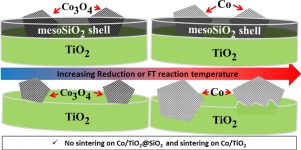Applied Catalysis A: General ( IF 4.7 ) Pub Date : 2017-12-23 , DOI: 10.1016/j.apcata.2017.12.015 Tumelo N. Phaahlamohlaka , Mbongiseni W. Dlamini , Mashikoane W. Mogodi , David O. Kumi , Linda L. Jewell , David G. Billing , Neil J. Coville

|
One of the pathways responsible for the deactivation of Fischer-Tropsch catalysts is the loss of active metal surface area due to nanoparticle agglomeration. To combat this effect efforts have been made to increase the interaction between the metal nanoparticles and the support using materials like silica. In this study, the supported metal particles were covered with a highly porous layer of silica to stabilize the Co nanoparticles on a titania support both during reduction and under reaction conditions. Co3O4 nanoparticles (size range: 8–12 nm) supported on titania were stabilized by coating them with a thin layer of mesoporous silica (4 nm) to make Fischer-Tropsch catalysts that are less prone to sintering (Co/TiO2@mSiO2). To mitigate the strong metal support interactions brought about by the titania and silica a Ru promoter was loaded together with the cobalt nanoparticles onto the titania (CoRu/TiO2@mSiO2). Temperature programmed XRD studies on the evolution of the Co metal nanoparticles showed that there was no significant particle size growth under reduction conditions in the temperature range from 30 to 600 °C. Chemisorption studies following reduction under hydrogen at 350 °C and 450 °C gave results consistent with the in situ XRD data when compared to the Co/TiO2. Fischer-Tropsch synthesis on the Co/TiO2@mSiO2 and CoRu/TiO2@mSiO2 catalysts encapsulated inside the mesoporous silica shell exhibited good catalytic performance without any display of significant mass transport limitations that might arise due to a silica shell coating of the active sites. For these two catalysts the Fischer-Tropsch activity increased with reduction temperature without any significant negative changes in their selectivity due to sintering, while the activity on Co/TiO2 decreased due to Co nanoparticle sintering.
中文翻译:

Ru助催化并负载在介孔二氧化硅包封的二氧化钛上的耐烧结的Co Fischer-Tropsch催化剂
导致费-托催化剂失活的途径之一是由于纳米颗粒的团聚导致活性金属表面积的损失。为了对抗这种效果,已经做出努力以使用诸如二氧化硅的材料来增加金属纳米颗粒与载体之间的相互作用。在这项研究中,负载的金属颗粒覆盖有一层高度多孔的二氧化硅,以在还原过程中和反应条件下稳定二氧化钛载体上的Co纳米颗粒。负载在二氧化钛上的Co 3 O 4纳米颗粒(尺寸范围:8–12 nm)通过在其上涂覆一层薄薄的中孔二氧化硅(4nm)以制备不易烧结的费-托催化剂(Co / TiO 2 @mSiO 2)。为了减轻二氧化钛和二氧化硅引起的强金属载体相互作用,将Ru促进剂与钴纳米颗粒一起加载到二氧化钛上(CoRu / TiO 2 @mSiO 2)。对Co金属纳米颗粒的演化进行程序升温X射线衍射研究表明,在还原条件下,温度范围为30至600°C,没有明显的粒径增长。与Co / TiO 2相比,氢在350°C和450°C下还原后的化学吸附研究得出的结果与原位XRD数据相符。Co / TiO 2上的费-托合成包封在介孔二氧化硅壳内部的@mSiO 2和CoRu / TiO 2 @mSiO 2催化剂表现出良好的催化性能,而没有显示出由于活性部位的二氧化硅壳涂层而可能引起的明显的传质限制。对于这两种催化剂,费-托活性随着还原温度的增加而增加,而没有由于烧结引起的选择性的任何显着的负变化,而由于钴纳米颗粒的烧结,对Co / TiO 2的活性降低了。











































 京公网安备 11010802027423号
京公网安备 11010802027423号